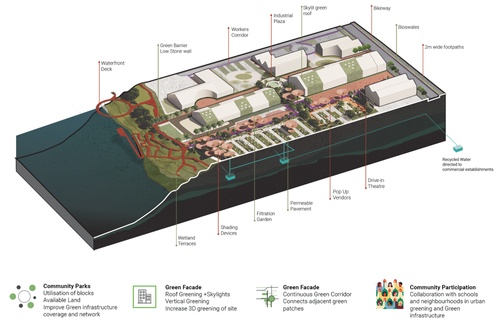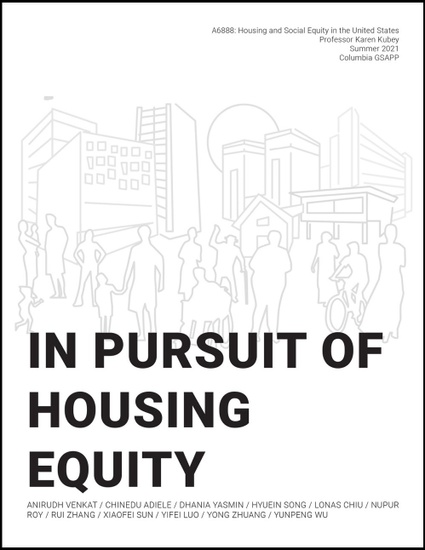Introduction
Urban Design
The Urban Design program engages the complex processes of global urbanization amid the emerging stress of the climate crisis. Ways of living in cities and landscapes around the world are increasingly untenable, and now require new forms of research and attention. What is the agency of design in these rapidly shifting conditions? The program frames the city not as a fixed, delineated territory but instead as a gradient of landscapes supported by networks of energy, resources, culture, mobility, and capital. It addresses near and long term threats to local, regional, and global ecosystems, positioning design as both an inclusive, activist, tools-based project for specific sites and communities, and as a critical project examining urban form, process, and knowledge.
Spring 2022
Studio III
Water Urbanism: Belize & the Yucatan
Through reimagining urban and coastal development practices, and foregrounding the notion of a blue economy, this studio aims to expand the concept of working landscapes and emergent urban ecology that takes into account health, food, equity, and economy. How can a project be defined as a working landscape and urban-scape that engages people, jobs and social life as a key part of its formation? What are new forms of work or collaboration that offer alternative economies for towns and cities along the coast? The studio is conceived of as one larger design initiative, one that imagines next century urbanism that co-exists with the resilient reef, and which is tested in eleven pilot sites. The studio began by undertaking broad investigations of the Mesoamerican Reef, the city of Belize, and the Yucatan Peninsula. Initial studies connect material flows linking the eleven transects along the Belize – Mexico terrain that explore the conflictual, dynamic, and emergent forms of life within the coast.
Teaching Assistants: Avani Agarwal, Lucas Coelho Netto, Cesar Delgado, Galina Novikova, Carmen Yu, Willy Cao
Students: Avani Agarwal, Bianca Bryant, Lucas Carvalho Macedo Coelho Ne, Riya Chadha, Junfan Chen, Lianghao Cheng, Surabhi Dahivalkar, Cesar Delgado, Daniela Deu, Tanuja Dhanasekaran, Samuel Dye, Giulia Figueiredo Chagas, Lamisa Haque, Jiamin Huang, Howie Jiang, Yasmine Katkhuda, Changbin Kim, Jisoo Kim, Minsung Kim, Jie Kong, Rae Lei, Jiaxin Li, Shuhua Li, Zhifan Li, Shinan Liu, Hao Ma, Gloria Mah, Aishwarya Mathukumilli, Achmad Maulana, Galina Novikova, Javier Ortiz, Rhea Rajesh Pai, Govardan Rajasekaran Umashankar, Kimberly Ramirez, Sydnee Sampson, Praditi Singh, Rongxin Tang, Rotina Tian, John Tiernan, Carmen Yu, Curran Zhang, Jiayi Zhao, Kenny Zhou, Lipeng Zhu
Fall 2021
Studio II
After Property: American Cities & Regional Contexts
This studio challenged participants to imagine and design zones of liberation within the loosely defined region of Metropolitan Atlanta. Each group worked on a specific model of collective care and stewardship that goes beyond the extractive model of private property. The proposals acknowledged the human and more-than-human factors, and indigenous cosmologies, which frame the ambiance of the place chosen for research and intervention. Therefore, instead of imaging an ideal client or a limitless budget, the aim was to refuse contributing to a world where arbitrary values are ascribed to human bodies and land. It is a willing ness to live with difference and care instead of a false sense of security. This vision is supported by multi-scalar spatial practices–from the infrastructural to the quotidian–that are simultaneously generous and uncompromising, radical and visionary, building a world after property.
Students: Avani Agarwal, Bianca Bryant, Lucas Carvalho Macedo Coelho Ne, Riya Chadha, Junfan Chen, Lianghao Cheng, Surabhi Dahivalkar, Cesar Delgado, Daniela Deu, Tanuja Dhanasekaran, Samuel Dye, Giulia Figueiredo Chagas, Lamisa Haque, Jiamin Huang, Howie Jiang, Yasmine Katkhuda, Changbin Kim, Jisoo Kim, Minsung Kim, Jie Kong, Rae Lei, Jiaxin Li, Shuhua Li, Zhifan Li, Shinan Liu, Hao Ma, Gloria Mah, Aishwarya Mathukumilli, Achmad Maulana, Galina Novikova, Javier Ortiz, Rhea Rajesh Pai, Govardan Rajasekaran Umashankar, Kimberly Ramirez, Sydnee Sampson, Praditi Singh, Rongxin Tang, Rotina Tian, John Tiernan, Carmen Yu, Curran Zhang, Jiayi Zhao, Kenny Zhou, Lipeng Zhu

Summer 2021
Urban Design Studio I
The Fall Semester Studio is an immersive and intensive city-making laboratory where students develop tools for designing resilient, equitable, vibrant, and healthy environments within the New York City Metropolitan Area. During this first studio of the program, the curriculum is focused on the scale of the neighborhood. Here the neighborhood is explored as both a social construct and as a physical territory, both central to popular, journalistic, political, and design discourses. Working in today’s postindustrial, socially inequitable, and climate-stressed conditions, the students are asked to critically interrogate and redefine the many layers of existing urban fabrics and infrastructures to address the challenges faced by current and future inhabitants. This year, the Fall Studio focuses on two sites, one at the southern tip of Manhattan (three bridges), the other at the northern tip (Harlem River) – each a neighborhood undergoing change and challenge.
Students: Avani Agarwal, Bianca Bryant, Lucas Carvalho Macedo Coelho Ne, Riya Chadha, Junfan Chen, Lianghao Cheng, Surabhi Dahivalkar, Cesar Delgado, Daniela Deu, Tanuja Dhanasekaran, Samuel Dye, Giulia Figueiredo Chagas, Lamisa Haque, Jiamin Huang, Howie Jiang, Yasmine Katkhuda, Changbin Kim, Jisoo Kim, Minsung Kim, Jie Kong, Rae Lei, Jiaxin Li, Shuhua Li, Zhifan Li, Shinan Liu, Hao Ma, Gloria Mah, Aishwarya Mathukumilli, Achmad Maulana, Galina Novikova, Javier Ortiz, Rhea Rajesh Pai, Govardan Rajasekaran Umashankar, Kimberly Ramirez, Sydnee Sampson, Praditi Singh, Rongxin Tang, Rotina Tian, John Tiernan, Carmen Yu, Curran Zhang, Jiayi Zhao, Kenny Zhou, Lipeng Zhu

Tanuja Dhanasekaran, Praditi Singh, Zhifan Li, Siyu Lei
Seminars
Spring 2022
Immeasurable Cities
This course considered spatial practices that travel beyond, above and below disciplinary boundaries of measurement. How do we measure cities? What would it mean to think about cities through the very things that architecture fails to represent? By and large, African cities—and more broadly, cities in the Global South—have been dominated by discursive and spatial regimes of quantification that facilitate ongoing practices of extraction. This seminar examined specific tactics of legibility and abstraction, in the visual and conceptual arts, that represent cities and spaces without measure. Participants meditated on concepts, environments and practices that are illegible to the broader fields of architecture, urban design and planning; spaces that are always already fleeting. This requires developing transdisciplinary knowledge of black studies, decoloniality, contemporary art, and cultural geography. The course considered multiple forms of measurement, classification, and bordering, that consolidate power and negate the lives of racialized, gendered, and discounted bodies.
Summer 2021
Housing and Social Equity in the U.S.
This seminar examined issues of race, gender, culture, disability, sexuality, age, health, economics, and climate in the domestic realm. This course asserts that housing design is political. Design is never neutral, but always communicates cultural, social, and economic values. This student-driven seminar investigated exemplary multi-family housing case studies and explore ways to visualize housing equity in the United States. Students drew from multidisciplinary sources including from design theory, oral history, and public health research.

Fall 2021
Community Engagement Practicum
In this seminar, students were introduced to different spaces, tools and processes of engagement in urban planning and design through case studies, guest speakers, and readings. Students were encouraged to discuss and envision new scenarios of visioning, collaborative storytelling, and shared ownership of planning and design processes and to develop their own “manifesto” for an engaged practice as part of an assignment to develop an engagement strategy for a particular project or issue in the second half of the semester. Learning objectives included:
- Developing an understanding of the history and principles of democratic planning and design processes
- Familiarization with contemporary and progressive practices, tools and methods of community engagement
- Developing and test individual principles for an engaged practice
Students: Riya Chadha, Lianghao Cheng, Surabhi Dahivalkar, Lamisa Haque, Jiamin Huang, Jisoo Kim, Jie Kong, Jiaxin Li, Zhifan Li, Shinan Liu, Hao Ma, Aishwarya Mathukumilli, Achmad Maulana, Galina Novikova, Rhea Rajesh Pai, Sydnee Sampson, Rongxin Tang, Curran Zhang, Jiayi Zhao, Lipeng Zhu

Fall 2021
Difference and Design
Rather than monumentally reinforcing difference, design can be a process and a tool to positively and systematically address difference. A growing field of designers, organizations, and offices have shown that this work can be central or at least integral to architecture, landscape architecture, and urban design practice. This emerging field has been called social design, impact design, design for good, design justice, and other monikers. This seminar explored the following key questions:
- How has the built environment been shaped by difference?
- How do we make a difference in the design of our spaces, places, and cities?
- How do you want to make a difference through your practice as a designer?
Students: Abriannah Aiken, Bianca Bryant, Lucas Carvalho Macedo Coelho Ne, Daniela Deu, Siyun Ji, Howie Jiang, Yasmine Katkhuda, Rae Lei, Stephanie McMorran, Javier Ortiz, Govardan Rajasekaran Umashankar, Praditi Singh, Rotina Tian, John Tiernan, Carmen Yu, Kenny Zhou

Spring 2022
Recombinant Urbanism
This seminar examined how cities grow and develop over time. It employed a theory of urban actors and conceptual models as tools for the analysis of the city, its urban systems and design ecologies. The course mapped transformations in these actors and their models at various scales over time in specific locations. Urban actors use conceptual models to link to the larger forces shaping a city network. Students constructed a layered model of a city of their own choosing as a group project and employed models derived from the course to illustrate the structure and growth of that city, including its representative public spaces and urban fabrics.
1
Portfolios



















































